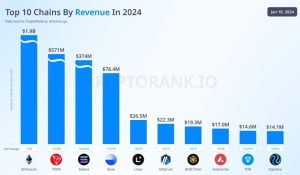Blockchain Revenue Review for 2024
The Future of Blockchain: Scaling for Mass Adoption and Profitability
As we approach 2025, a major topic of conversation in the blockchain space will revolve around the ability of these networks to onboard millions of users across various applications and integrations. Over the past few years, developers have been building a robust ecosystem of decentralized applications (dApps), financial tools, and integrations, setting the stage for mass adoption. However, the real question lies in how quickly these users can generate profits for blockchain networks—a factor that depends heavily on user traction and the competitive landscape among different blockchains.
Key Factors Driving Blockchain Success
- Transaction Processing Speed (TPS): One of the most critical metrics for blockchain scalability is Transactions Per Second (TPS). This measures how quickly and efficiently a blockchain can validate and process transactions, including smart contracts. High TPS is essential for supporting large-scale user activity without bottlenecks or delays. Blockchains that excel in this area will be better positioned to attract users and businesses.
- Efficiency and Transparency: Blockchains have the potential to outperform legacy systems by offering faster, more transparent transaction processing. By leveraging decentralized technology, blockchains can reduce inefficiencies and eliminate intermediaries, providing a superior alternative to traditional financial systems.
- Competing with Traditional Payment Networks: For blockchains to stand out, they must prove their superiority over existing payment networks like SWIFT, VISA, and Mastercard. This includes not only matching their speed and reliability but also offering unique advantages such as lower fees, enhanced security, and global accessibility.
The Path to Profitability
The timeframe for blockchains to generate profits from their growing user base will vary based on several factors:
- Traction: The more users a blockchain can attract—and retain—the faster it can achieve profitability. This requires not only technical scalability but also compelling use cases that drive adoption.
- Competition: With numerous blockchains vying for dominance, only those with superior technology, user experience, and strategic partnerships will emerge as leaders.
- Ecosystem Development: A thriving ecosystem of dApps and integrations will play a crucial role in driving user engagement and transaction volume.
Lets check out a visual below going over some 2024 statistics.
 (Data Source: CryptoRank.io, Artemis.xyx)
(Data Source: CryptoRank.io, Artemis.xyx)
- Ethereum Dominates:
- Ethereum leads with $1.9 billion in revenue, maintaining its position as the most profitable blockchain despite a slight year-over-year (YoY) decline of -1.7%.
- Its dominance is driven by its extensive ecosystem of decentralized finance (DeFi) protocols, NFTs, and smart contracts.
- TRON and Solana Show Strong Growth:
- TRON generated $571 million in revenue, with a YoY growth of +34.8%, benefiting from its focus on stablecoin transfers and low transaction fees.
- Solana ranks third with $374 million in revenue, showing an impressive YoY growth of +2,844%, likely due to its high-speed transactions and growing DeFi and NFT ecosystems.
- Emerging Chains:
- Base ($78.4M, +1,217%) and Linea ($26.5M, +306%) are notable new entrants, reflecting the rise of Layer 2 solutions that enhance scalability for Ethereum.
- TON ($14.6M, +2,499%) demonstrates rapid growth, potentially due to its integration with Telegram’s user base.
- Decline for Avalanche:
- Avalanche saw a significant YoY revenue drop of -73.7%, possibly due to reduced DeFi activity or competition from other chains.
- BNB Chain and Injective:
- BNB Chain ($19.3M) grew modestly by +8.1%, while Injective ($14.1M) had a strong YoY increase of +809%, reflecting growing interest in decentralized derivatives and financial applications.
